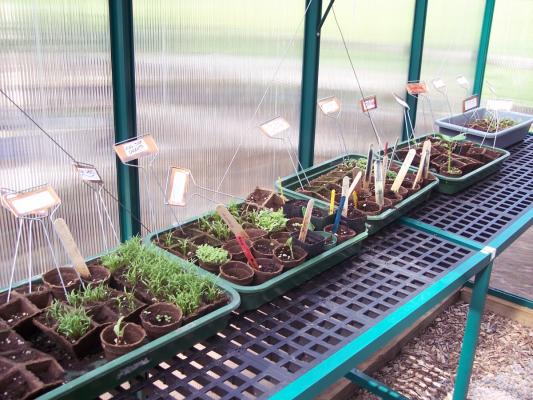Greenhouses
Despite the initial construction costs, ongoing expense for utilities, and staff time required for maintenance and management, a greenhouse can be a place of magic. It is not the structure of wood, plastic, or glass that is the magic, but rather what takes place within.
Outdoor gardens are subject to the mercy of the climates in which they exist. They depend on the weather for heat and light and are bound by seasonal conditions for flowers to bloom and vegetables to grow. In a well-designed and managed greenhouse, these seasonal limitations largely disappear because you can control the temperature, humidity, and ventilation. Lights can be used to extend the day length. A school with a greenhouse is truly fortunate.
Several schools in San Diego County have greenhouses that were built by 4H, PTA parents, or a local Boy Scout troop looking for a community project. In a middle school or high school, the Industrial Arts Department may assist in a greenhouse construction project to challenge advanced and creative students. When selecting a place for the greenhouse, make sure the site is not in an area designated for future classroom expansion. Basic greenhouse plans are available in many gardening books and at some “do-it-yourself centers”. Greenhouse selection depends on several factors: size, orientation, location, intended use, and the amount of money available for its construction.

The structure need not be complex. A simple wood frame covered with a clear or translucent plastic, a method of ventilation, and a door is all that is required. Translucent plastic panels are recommended. They are less expensive, easier to repair, and less subject to breakage than glass. A heater may not be required unless you are in an area where the temperature drops to freezing. High daytime temperatures and low humidity can be controlled with a ventilation fan and misters.

Another advantage of greenhouse gardening is the ability to grow exotic plants with beautiful foliage and exquisite flowers. Plants such as orchids can thrive in a greenhouse, but will not do well without a controlled environment.
Hydroponic Gardens
A greenhouse is also an ideal location for a hydroponic system. Hydroponic gardening is a method of growing plants in a nutrient rich solution without soil. You can grow plants with their roots in water or in an inert growing medium such as perlite, gravel or coconut husks. Faster, better growth, greater yields, and fewer resources are among the reasons that hydroponic culture is being used around the world for commercial food production and by many home gardeners. The novelty of the technology appeals to many middle and high school students.
A hydroponic garden takes little space and is ideal for the classroom because it offers the students a laboratory for controlled experimentation for growing plants. It can be located almost anywhere: in a container on a patio, in a greenhouse, in front of a south facing window, or on a shelf in a classroom. All that is required is electricity to run the equipment, sufficient light (either natural or artificial), and the proper temperature.
Despite the high cost of setting up the system and the required regular monitoring, advantages of a hydroponic garden are automatic watering and feeding, no cultivating or weeding, no mulching or soil-borne diseases, and low water use. Not all plants will adapt to hydroponic growing techniques.
Many excellent books and pamphlets written on the subject are available at sources that offer hydroponic equipment and supplies and in the gardening section of large bookstores.
Aquaponics is another form of agriculture that combines raising fish in tanks (recirculating aquaculture) with soilless plant culture hydroponics). In aquaponics, the nutrient-rich water from raising fish provides a natural fertilizer for the plants, and the plants help to purify the water for the fish.
Array